
Messier 109 is a barred spiral galaxy exhibiting a weak inner ring structure around the central bar approximately 67.2 ± 23 million light-years away in the northern constellation Ursa Major. M109 can be seen south-east of the star Phecda.

NGC 4449, also known as Caldwell 21, is an irregular Magellanic type galaxy in the constellation Canes Venatici, being located about 13 million light-years away. It is part of the M94 Group or Canes Venatici I Group that is relatively close to the Local Group hosting our Milky Way galaxy.

NGC 3344 is a relatively isolated barred spiral galaxy located 22.5 million light years away in the constellation Leo Minor. This galaxy belongs to the group known as the Leo spur, which is a branch of the Virgo Supercluster. NGC 3344 has the morphological classification (R)SAB(r)bc, which indicates it is a weakly barred spiral galaxy that exhibits rings and moderate to loosely wound spiral arms. There is both an inner and outer ring, with the prominent arms radiating outward from the inner ring and the slightly elliptical bar being situated inside. At the center of the bar is an HII nucleus with an angular diameter of about 3″. NGC 3344 hosted supernova SN 2012fh, which was shown to likely be a Type Ib or Type Ic.

A galaxy group or group of galaxies (GrG) is an aggregation of galaxies comprising about 50 or fewer gravitationally bound members, each at least as luminous as the Milky Way (about 1010 times the luminosity of the Sun); collections of galaxies larger than groups that are first-order clustering are called galaxy clusters. The groups and clusters of galaxies can themselves be clustered, into superclusters of galaxies.

NGC 6104 is a barred spiral galaxy located in the constellation Corona Borealis. It is designated as S(R)Pec in the galaxy morphological classification scheme, though it is clearly a barred spiral, and was discovered by William Herschel on 16 May 1787. The galaxy is approximately 388 million light-years away.

NGC 654 is an open cluster in the constellation Cassiopeia. It was discovered by William Herschel in 1787. With apparent magnitude 6.5, it can be observed by binoculars. It is located 2,5° northeast of the star Delta Cassiopeiae. In the same low power field can also be seen the open clusters NGC 663 and NGC 659. It surrounds a 7th magnitude yellowish star, an F5Ia supergiant, which is a possible member of the group.
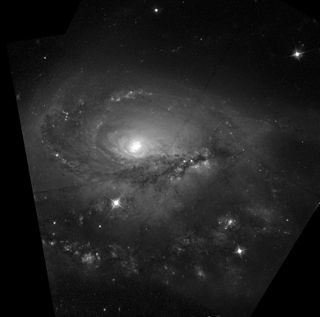
NGC 1961 is a spiral galaxy in the constellation Camelopardalis. It was discovered by William Herschel on 3 December 1788. It is at a distance of about 200 million light years from Earth, which, given its apparent dimensions, means that NGC 1961 is more than 220,000 light years across. The galaxy has been distorted, however no companion has been detected nor double nuclei that could show a recent merger. Its outer arms are highly irregular. Two long straight arms extent from the north side of the galaxy. A luminous X-ray corona has been detected around the galaxy. NGC 1961 is the central member of the small group of nine galaxies, the NGC 1961 group.

NGC 375 is an elliptical galaxy located in the constellation Pisces. It was discovered on September 12, 1784 by William Herschel. It was described by Dreyer as "pretty faint, small, round, brighter middle." Along with galaxies NGC 379, NGC 380, NGC 382, NGC 383, NGC 384, NGC 385, NGC 386, NGC 387 and NGC 388, NGC 375 forms a galaxy cluster called Arp 331.
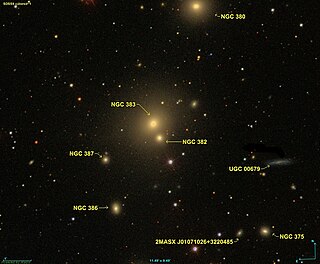
NGC 382 is an elliptical galaxy located in the constellation Pisces. Its discovery has been credited to William Parsons.

NGC 380 is an elliptical galaxy located in the constellation Pisces. It was discovered on September 12, 1784 by William Herschel. It was described by Dreyer as "pretty faint, small, round, suddenly brighter middle." Along with galaxies NGC 375, NGC 379, NGC 382, NGC 383, NGC 384, NGC 385, NGC 386, NGC 387 and NGC 388, NGC 380 forms a galaxy cluster called Arp 331.

NGC 384 is an elliptical galaxy located in the constellation Pisces. It was discovered on November 4, 1850 by Bindon Stoney. It was described by Dreyer as "pretty faint, pretty small, southwestern of 2.", the other being NGC 385. Along with galaxies NGC 375, NGC 379, NGC 382, NGC 383, NGC 385, NGC 386, NGC 387 and NGC 388, NGC 384 forms a galaxy cluster called Arp 331.
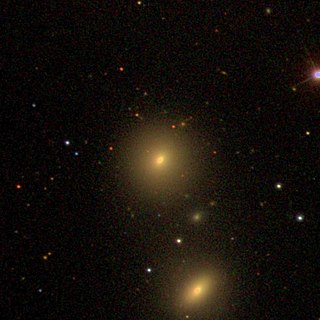
NGC 385 is an unbarred lenticular galaxy located in the constellation Pisces. It was discovered on November 4, 1850 by Bindon Stoney. It was described by Dreyer as "pretty faint, pretty small, round, northeastern of 2.", the other being NGC 384. Along with galaxies NGC 375, NGC 379, NGC 382, NGC 383, NGC 384, NGC 386, NGC 387 and NGC 388, NGC 385 forms a galaxy cluster called Arp 331.
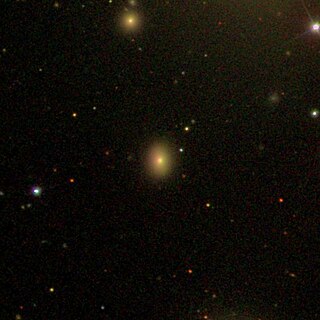
NGC 386 is an elliptical galaxy located in the constellation Pisces. It was discovered on November 4, 1850 by Bindon Stoney. It was described by Dreyer as "considerably faint, small, round." Along with galaxies NGC 375, NGC 379, NGC 382, NGC 383, NGC 384, NGC 385, NGC 387 and NGC 388, NGC 386 forms a galaxy cluster called Arp 331.
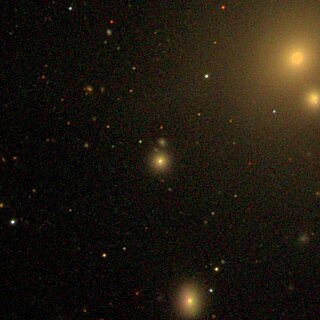
NGC 387 is an elliptical galaxy located in the constellation Pisces. It was discovered on December 10, 1873 by Lawrence Parsons. It was described by Dreyer as "very faint, small, round." Along with galaxies NGC 375, NGC 379, NGC 382, NGC 383, NGC 384, NGC 385, NGC 386 and NGC 388, NGC 387 forms a galaxy cluster called Arp 331.

NGC 3312 is a large and highly inclined spiral galaxy located about 194 million light-years away in the constellation Hydra. The galaxy was discovered by astronomer John Herschel on March 26, 1835. It was later rediscovered by astronomer Guillaume Bigourdan on February 26, 1887. NGC 3312 was later listed and equated with IC 629 because the two objects share essentially the same celestial coordinates. NGC 3312 is the largest spiral galaxy in the Hydra Cluster and is also classified as a LINER galaxy.
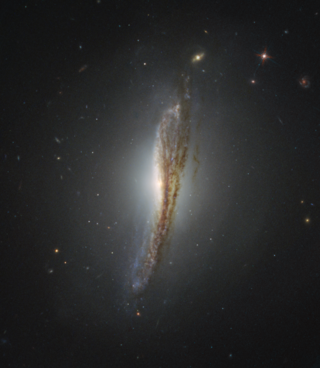
NGC 612 is a lenticular galaxy in the constellation of Sculptor located approximately 388 million light-years from Earth. It is a type II Seyfert galaxy and thus has an active galactic nucleus. NGC 612 has been identified as an extremely rare example of a non-elliptical radio galaxy, hosting one of the nearest powerful FR-II radio sources.

NGC 7469 is an intermediate spiral galaxy in the constellation of Pegasus. NGC 7469 is located about 200 million light-years away from Earth, which means, given its apparent dimensions, that NGC 7469 is approximately 90,000 light-years across. It was discovered by William Herschel on November 12, 1784.
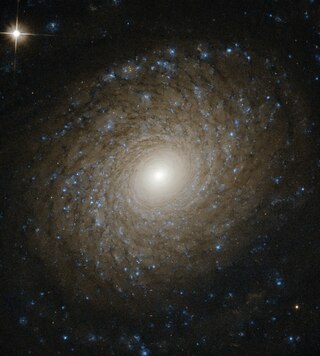
NGC 2985 is a spiral galaxy located in the constellation Ursa Major. It is located at a distance of circa 70 million light years from Earth, which, given its apparent dimensions, means that NGC 2985 is about 95,000 light years across. It was discovered by William Herschel on April 3, 1785.

The NGC 4065 Group is a group of galaxies located about 330 Mly (100 Mpc) in the constellation Coma Berenices. The group's brightest member is NGC 4065 and located in the Coma Supercluster.

NGC 3664 is a magellanic barred spiral galaxy in the constellation of Leo. It is located about 80 million light years away from Earth, which means, given its apparent dimensions, that NGC 3664 is approximately 50,000 light years across. It was discovered by Wilhelm Tempel on March 14, 1879. It is a member of the NGC 3640 Group of galaxies, which is a member of the Leo II Groups, a series of galaxies and galaxy clusters strung out from the right edge of the Virgo Supercluster.




















